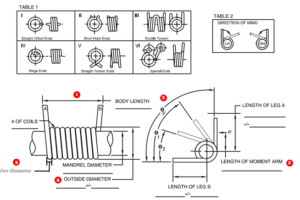Torsion Spring Calculation: A Guide to Designing Efficient and Reliable Systems

Torsion springs are widely used in mechanical systems to provide the necessary torque for various applications. Designing torsion springs requires careful calculation to ensure optimal performance, longevity, and safety. This article serves as a comprehensive guide to torsion spring calculation, covering key parameters, formulas, and considerations for designing efficient and reliable systems.
Key Parameters and Formulas:
1. Spring Constant (K):
The spring constant, also known as the torque rate, determines the relationship between the applied torque and the resulting angular deflection of the spring. It is measured in units of torque per unit of angle, such as Nm/radian or lb-in/degree. The spring constant can be calculated using the formula:
K = (Gd^4)/(32N-1D^3)
Where:
K = Spring constant
G = Shear modulus of the material
d = Wire diameter
N = Number of active coils
D = Mean coil diameter (outside diameter minus wire diameter)
2. Angular Deflection (θ):
The angular deflection of a torsion spring refers to the rotational displacement when subjected to an external torque. It can be calculated using the formula:
θ = (Tl)/(K)
Where:
θ = Angular deflection
T = Applied torque
l = Length of the moment arm
3. Stress and Fatigue Life:
During torsional loading, it is crucial to consider the stress levels experienced by the spring material to ensure its durability. The stress in a torsion spring can be calculated using the formula:
σ = (8KT)/(πd^3)
Where:
σ = Stress
K = Spring constant
T = Applied torque
d = Wire diameter
Considerations for Designing Torsion Springs:
1. Load Requirements:
Determine the required torque and angular deflection based on the specific application and load conditions. Consider factors such as weight, dimensions, and environmental conditions that may affect the performance of the torsion spring.
2. Material Selection:
Choose a suitable material based on the application requirements, considering factors such as strength, durability, and resistance to corrosion and fatigue. Common materials used for torsion springs include high-carbon steel, stainless steel, and alloy steel.
3. Space Limitations:
Consider the available space for the installation of the torsion spring. Ensure that the dimensions, including the wire diameter, coil diameter, and number of active coils, are compatible with the allocated space.
4. Safety and Stress Analysis:
Perform stress analysis to assess the stress levels within the torsion spring and ensure that they remain within the material’s allowable limits. This analysis will help determine the spring’s fatigue life and ensure its reliability and safety over an extended period.
Torsion spring calculation Conclusion:
Accurate torsion spring calculation is crucial for designing efficient and reliable systems. By considering key parameters, such as spring constant, angular deflection, stress, and fatigue life, engineers can design torsion springs that meet the specific requirements of diverse applications. Adhering to industry standards and incorporating safety measures ensures optimal performance, longevity, and safety in torsion spring systems.






